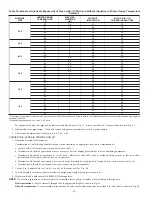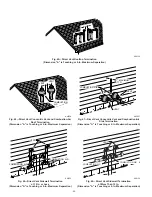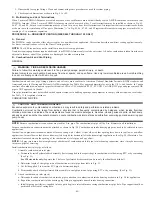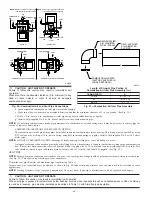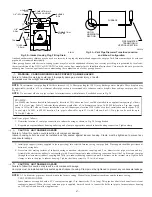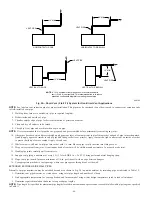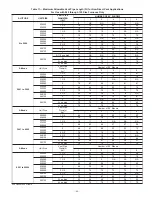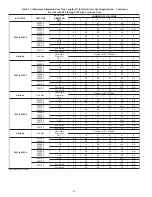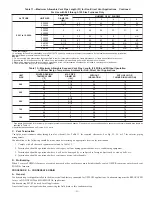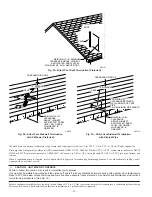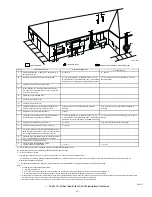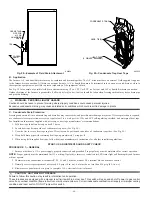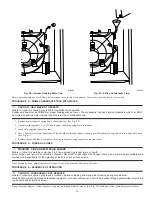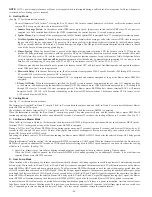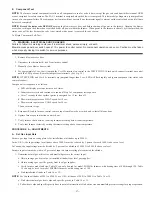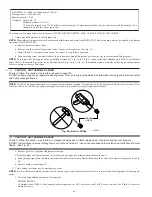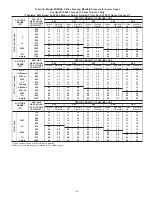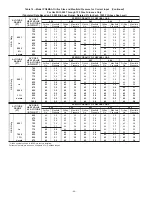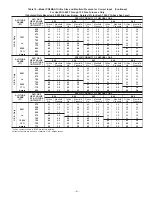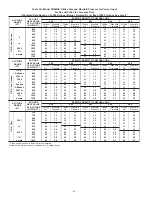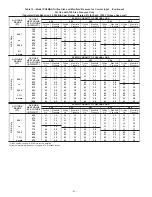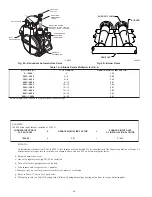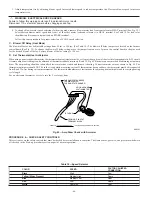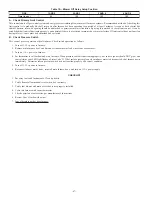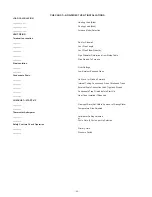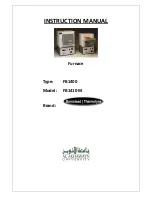
NOTE:
If 115-v power supply to furnace or blower access panel switch is interrupted during a call for heat, blower operates for 90 sec when power
is restored before heating cycle is resumed.
A.
Heating Mode
(See Fig. 31 for thermostat connections.)
The wall thermostat
″
calls for heat
″
, closing the R to W circuit. The furnace control performs a self-check, verifies the pressure switch
contacts PRS are open, and starts the inducer motor IDM.
a. Inducer Prepurge Period- As the inducer motor IDM comes up to speed, the pressure switch contacts PRS close, 24 vac power is
supplied for a field installed humidifier at the HUM terminal and the control begins a 15-second prepurge period.
b. Igniter Warm-Up- At the end of the prepurge period, the Hot-Surface Igniter HSI is energized for a 17-second igniter warm-up period.
c. Trial-for-Ignition Sequence- When the igniter warm-up period is completed the main gas valve relay contacts GVR close to energize
the gas valve GV, the gas valve opens. The gas valve GV permits gas flow to the burners where it is ignited by the Hot Surface Igniter
HSI. Five seconds after the GVR closes, a 2-second flame period begins. The HSI igniter will remain energized until the flame is sensed
or until the 2-second flame proving period begins.
d. Flame-Proving- When the burner flame is proved at the flame-proving sensor electrode FSE, the furnace control CPU begins the
blower-ON delay period and continues to hold the gas valve GV open. If the burner flame is not proved within two seconds, the control
CPU will close the gas valve GV, and the control CPU will repeat the ignition sequence for up to three more Trials-For-Ignition before
going to Ignition-Lockout. Lockout will be reset automatically after three hours, by momentarily interrupting 115 vac power to the
furnace, or by interrupting 24 vac power at SEC1 or SEC2 to the furnace control CPU (not at W, G, R, etc.)
If flame is proved when flame should not be present, the furnace control CPU will lock out of Gas-Heating mode and operate the inducer
motor IDM until flame is no longer proved.
e. Blower-On Delay- If the burner flame is proven, the blower motor is energized on HEAT speed 66 seconds (040 through 120 sizes) or
45 seconds (140 size) after the gas valve GV is energized.
Simultaneously, the electronic air cleaner terminal EAC-1 is energized and remains energized as long as the blower motor BLWM is
energized.
f. Blower-Off Delay- When the thermostat is satisfied, the R-to-W circuit is opened, de-energizing the gas valve GV, stopping gas flow
to the burners, and de-energizing the humidifier terminal HUM. The inducer motor IDM will remain energized for a 15-second (040
through 120 sizes) or 5-second (140 size) post-purge period. The blower motor BLWM and air cleaner terminal EAC-1 will remain
energized for 90, 120, 150, or 180 seconds (depending on the blower-OFF delay selection). The furnace control CPU is factory-set for
a 120-second blower-OFF delay.
B.
Cooling Mode
(See Fig. 31 for thermostat connections)
The thermostat closes the R-to-G-and-Y circuits. The R-to-Y circuit starts the outdoor unit, and the R-to-G and-Y circuits start the furnace blower
motor BLWM on COOL speed.
The electronic air cleaner terminal EAC-1 is energized with 115 vac when the blower motor BLWM is operating.
When the thermostat is satisfied, the R-to-G-and-Y circuits are opened. The outdoor unit will stop, and the furnace blower motor BLWM will
continue operating on the COOL speed for an additional 90 seconds. Cut jumper J2 to reduce the cooling off-delay to 5 seconds. (See Fig. 35.)
C.
Continuous Blower Mode
When the R-to-G circuit is closed by the thermostat, the blower motor BLWM will operate on continuous-blower speed (same as HEAT speed).
Terminal EAC-1 is energized as long as the blower motor BLWM is energized.
During a
″
call for heat,
″
the blower BLWM will stop during igniter warm-up (17 seconds), ignition (7 seconds), and blower-ON delay (66 or 45
seconds for 040 through 120 sizes or for 140 size), allowing the furnace heat exchangers to heat up more quickly, then restarts at the end of the
blower-ON delay period at HEAT speed.
In heating, the furnace control CPU will continue running the blower motor BLWM at HEAT speed after the selected blower-OFF delay period
is completed.
When the thermostat
″
calls for cooling
″
, the blower motor BLWM will operate at COOL speed. When the thermostat is satisfied, the blower motor
BLWM will operate an additional 90 seconds on COOL speed before reverting back to HEAT speed. Jumper J2 can be cut to reduce the cooling
off-delay to 5 seconds. (See Fig. 35.)
6. Insert 2-in. diameter pipe into inducer housing through neoprene coupling and clamp in inducer housing. Tighten clamp.
When the R-to-G circuit is opened, the blower motor BLWM will continue operating for an additional 5 seconds, if no other function
requires blower motor BLWM operation.
D.
Heat Pump Mode
When installed with a heat pump, the furnace control automatically changes the timing sequence to avoid long blower off times during demand
defrost cycles. When the R-to-W-and-Y or R-to-W-and-Y-and-G circuits are energized the furnace control CPU will continue to turn on the blower
motor BLWM at HEAT speed, and begin a heating cycle. The blower motor BLWM will remain on until the end of the prepurge period, then shut
off for 24 seconds then come back on at HEAT speed. When the W input signal disappears, the furnace control begins a normal inducer post-purge
period and the blower switches to COOL speed after a 3 second delay. If the R-to-W-and-Y-and-G signals disappear at the same time, the blower
motor BLWM will remain on for the selected blower-OFF delay period. If the R-to-W-and-Y signals disappear, leaving the G signal, the blower
motor BLWM will continue running the blower motor BLWM at HEAT speed after the selected blower-OFF delay period is completed.
Control initiates a 90-sec blower only on period before starting another heat pump cycle if there is a power interruption. Anytime control senses
false flame, control locks out of heating mode. This reaction occurs because control ignores W input due to false flame signal and, as a result, sees
only Y input and goes into cooling mode blower off delay. All other control functions remain in standard format.
—56—
Summary of Contents for PG9MAA
Page 70: ... 70 ...
Page 71: ... 71 ...

